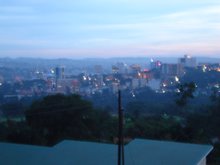
The second morning in Cape Town we left early for Robben Island, where, of course, Nelson Mandela was imprisoned for 27 years.

Each night when the hotel staff turned down the beds, they left behind a little story about some aspect of the country. The night before we went to Robben Island, the booklet was, funnily enough, about Robben Island, a piece by Lawrence G. Green, published posthumously in 1973, but unclear when originally written:
“When human beings live on an island for more than four centuries and then suddenly abandon it, they must leave behind them something more than empty houses, roads and gardens. There remains an atmosphere which hangs heavily over the deserted streets and homes…Robben Island lies across the entrance to Table Bay, five miles from Cape Town—a low island, often covered with fog, the grave of many ships. Five miles, but it might be a different world. In the past it was an island of suffering and exile; an island of desperate men, or dying men. They have dynamited the leper hospitals, but that air of old tragedy clings to the ruins. Even a stranger, knowing nothing of the island’s story, would sense it. If there is a place in the world where restless ghosts prowl round broken walls, it is Robben Island.”
Was there a time in between the leper colonies and the political prisoners? In the ‘40s? This must have been written before the ‘60s when Mandela arrived. There is housing to accommodate 2,000 residents, though only a few hundred live there now. A school educates about 30 kids each year. It must be a strange place to live.
Once you get off the ferry, passengers are ferried onto buses, which take you around part of the island and a tour guide gives a hard-to-understand-because-of-her-accent-and-a-not-so-good-microphone commentary on various points of interest and stops for photo shoots.

Then the bus brings you to the cell blocks where a different tour guide, one who actually spent time as a prisoner on the island, shows you around.

Notice my artistic use of shadow to represent the bars of his imprisonment. Also, you may look at this photo and notice the girl in the background wearing short pants and a short-sleeved shirt and think, wow, it must have been so nice and warm there. While it was a beautiful sunny day, it was not warm. We just happened to be grouped with a crowd of seriously misinformed girls who walked around with goose pimples all morning. The picture below is better because you can see that other people are wearing wool hats.


No comments:
Post a Comment